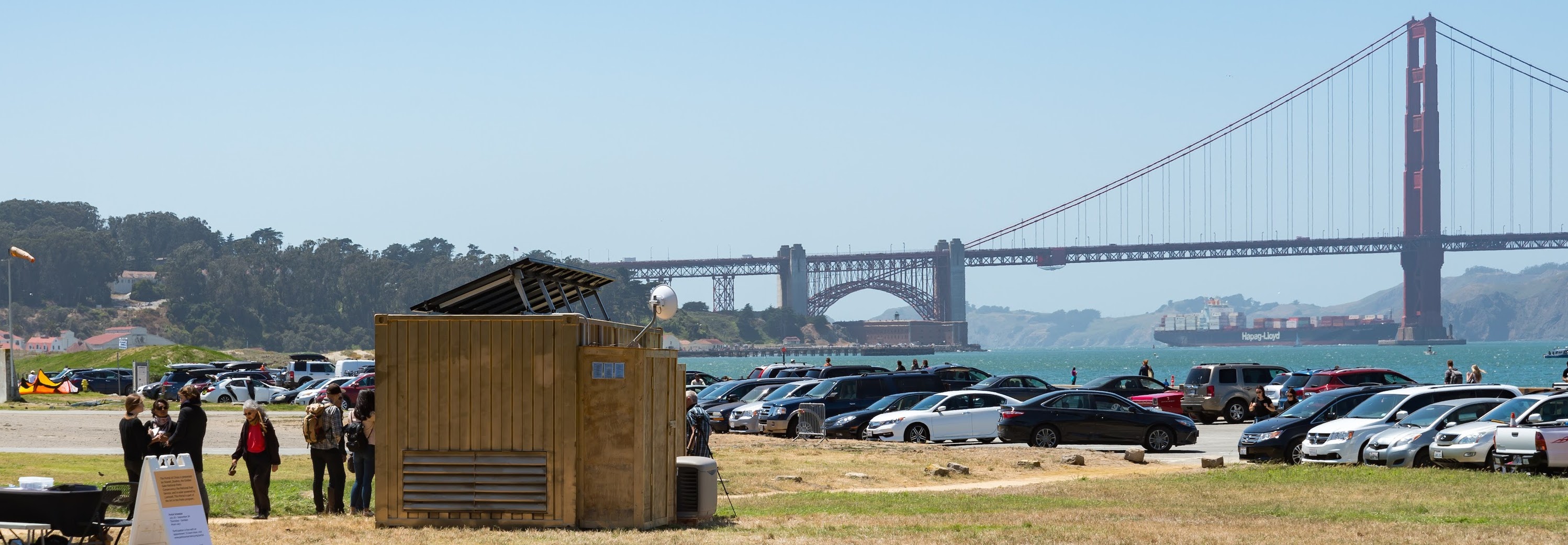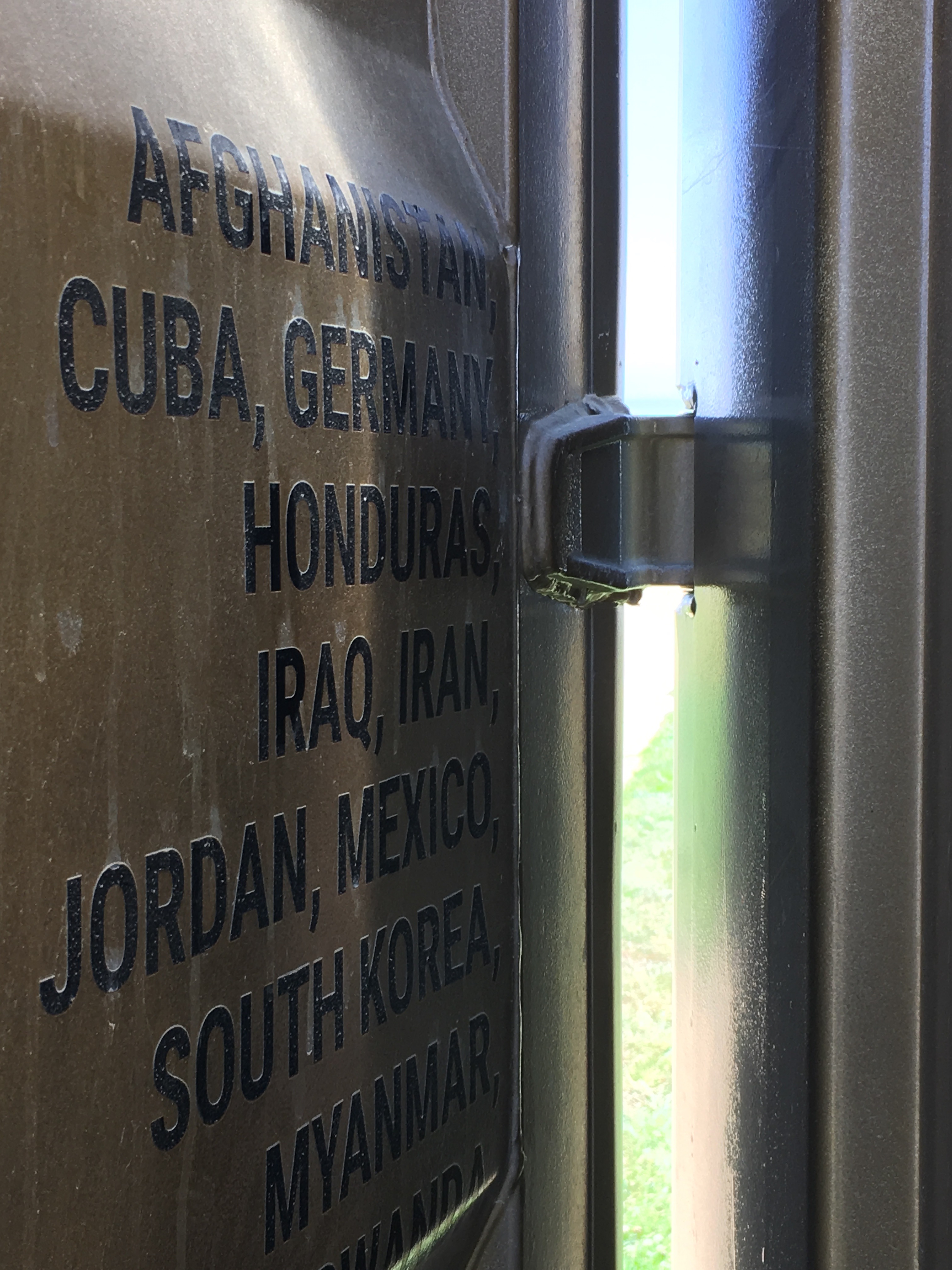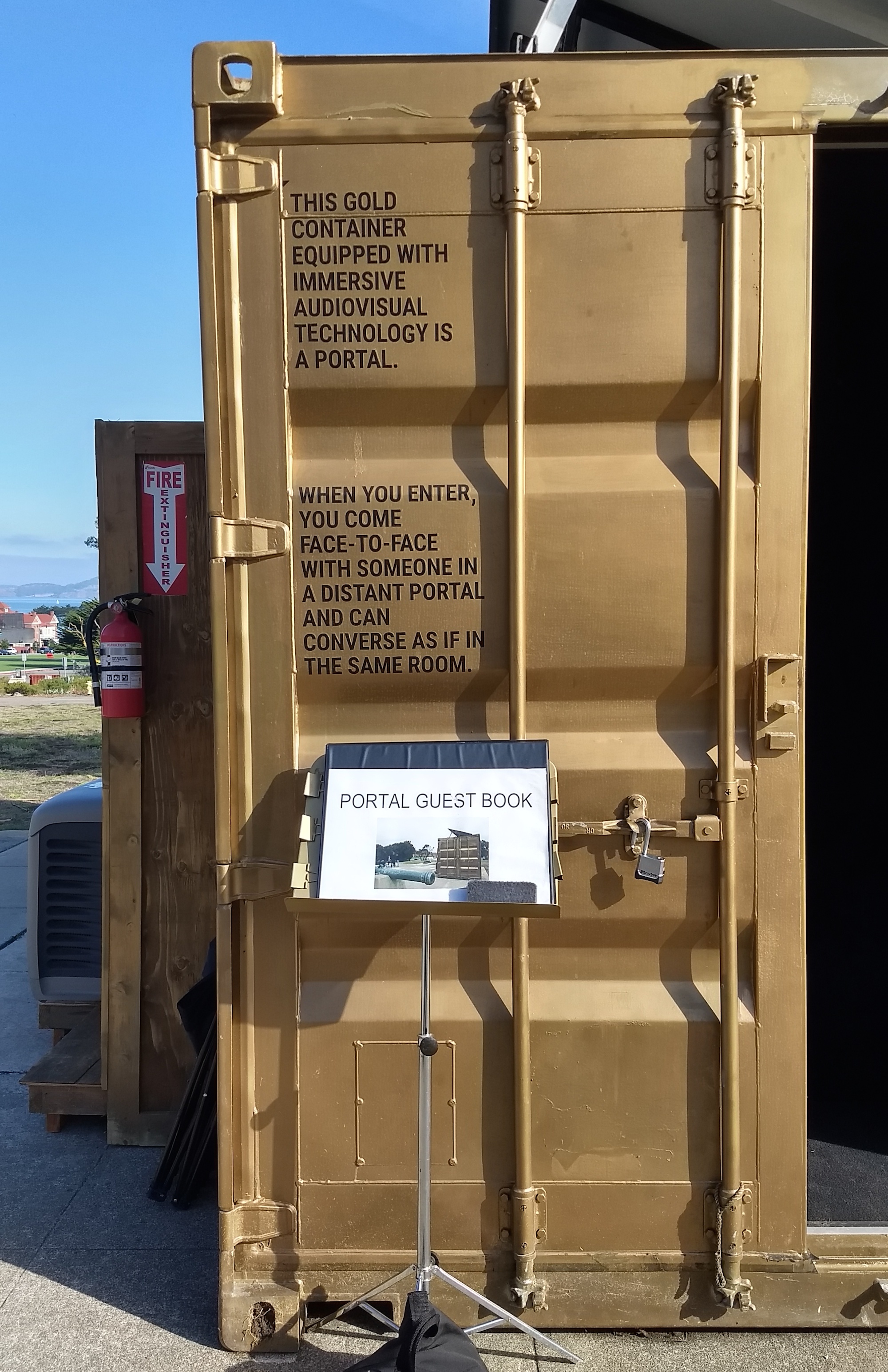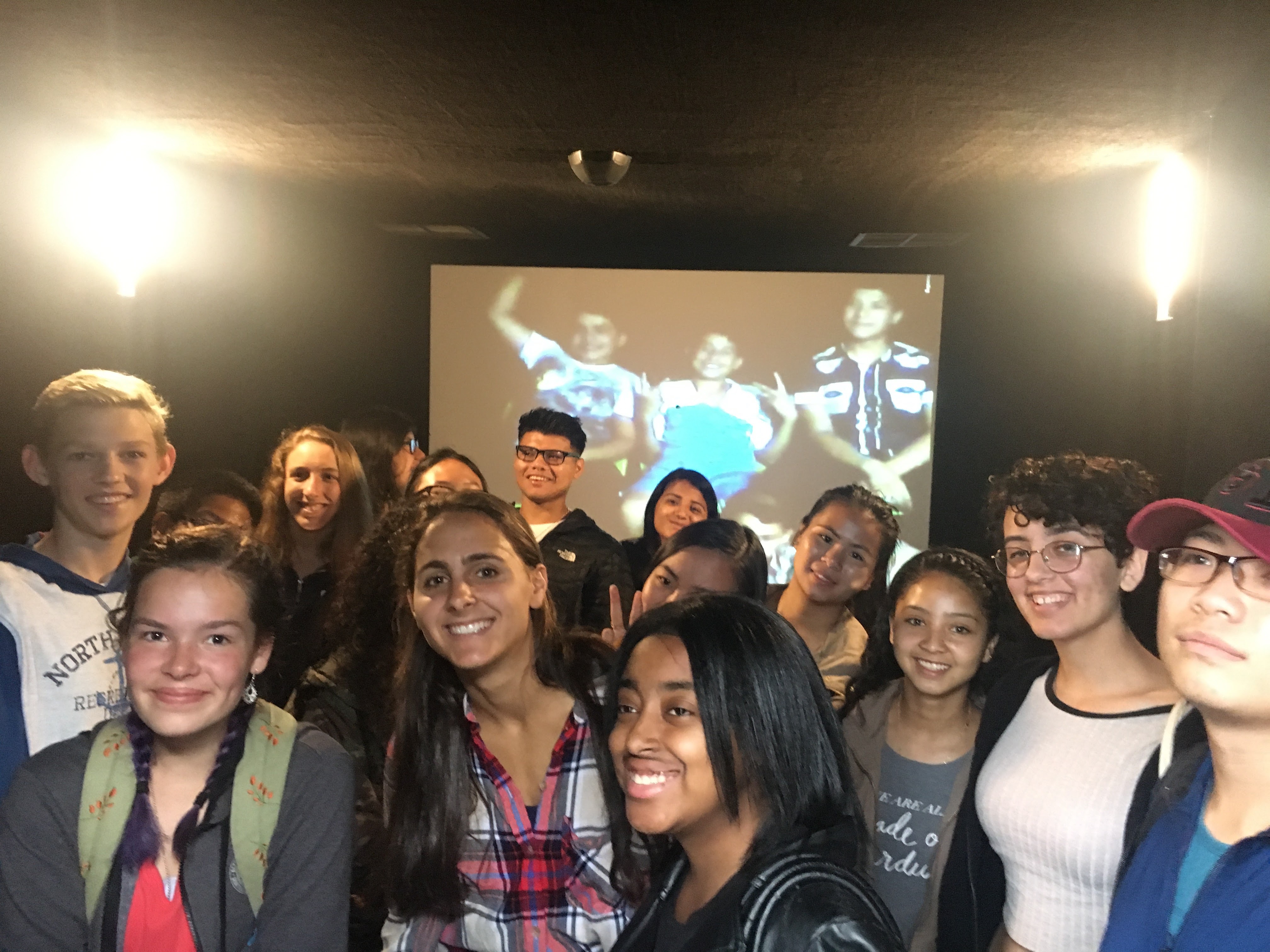The Portals Project | San Francisco, CA / Herat, Afghanistan
An amazing project that is allowing face-to-face conversations between people across distances around the world.

On a beautiful, clear breezy day and within sight of San Francisco’s Golden Gate Bridge, we walked through fresh dew on the grass of Crissy field to an average sized, metallic gold storage container. We found the door open with a dark curtain containing the magic within: “a cocoon-like setting to imply safety, time, permission.”1
We, myself and fellow EAS staffer, entered to find an entirely black room, apart from the far wall completely occupied by a large screen. Upon the screen was a life-sized video feed of two seated young men. They both smiled and waved as we entered. It made me think about this gesture. A smile and a wave, both are friendly, welcoming, even caring gestures. These two men didn’t know us. They had no idea who we were, yet, in the following twenty minutes, they extended their space, their stories, and their understanding to us.

They introduced themselves as Herat's Portals Project curators from Shared Studios. The San Francisco portal curator, Anne-Marie Litak, later described her experience working with curators across the country and across the world. “There is such a variety [of perspectives] with all of these curators [currently 30 in 22 sites worldwide]! The constants are the curiosity, the patience, and the immense heart that I see in these other organizers. It is tricky to disarm strangers; it takes a certain kind of casual love of Other. I am really inspired by the warmth, inclusion, and dexterity that I witness in these curators. The differences I see--oh, everything--dress, directness or shyness in conversation, education or ideas around ambition, relationship priorities, sexuality norms, religious beliefs, family dynamics, involvement in politics, sense of possibility or lack thereof. It is really astounding.” 2
In the same vein of sharing cultures and embracing differences, Emergent Art Space also uses art as a gateway to conversation. EAS’s global focus is on building communications, across culture, transcending language barriers through art.
The curators in Afghanistan, Khaled Salar and Saied Habibi, communicated with us in English and have traveled past the borders of Herat, Afghanistan, from where they were in a portal themselves. Saied is from Iran but moved with his family to study. Khaled started travelling to the United States when he was a student as part of an exchange program and continues to travel for work. They both work with people by day, as a soon-to-be professor and educator of teachers, respectively. I admired the effort they made to bridge the gaps in communication and was inspired to put aside my reservations of not being able to relate to their lives.

We eventually delved into a conversation about teaching and the wonderful privilege it is to get to work with students, to be able to witness their “aha” moments and build circumstances where their creativity thrives. Saied and I found common ground in math and problem solving. We even enjoyed trying to convince Khaled of math’s beauty and virtues.
By the end we mentioned the weather. But it’s not like when you are in the same place as someone and you talk about the weather. This wasn’t small talk. Anne-Marie says, “sometimes, I could see how it's a shame to not be able to share a conversation on the surroundings--to refer to little details and jump into a conversation from there. The surroundings can still be described, though!” 3 This wasn’t an exchange of pleasantries. This portal is an isolated space, yet it transported us to a common ground, like an embassy, a sort of ceasefire or peace zone between two nations, but instead between people.
The weather was vastly different between fall in San Francisco and Herat. But weather is something we have all talked about. We all know what the sun is, what it feels like. What it is to be cold. To wear layers. To get a runny nose from the chilly air. There is common ground among all people.
Sharing laughs, likes, and dislikes, we formed a bond with the Afghani curators in the twenty or thirty minutes we spoke. There wasn’t a moment of silence, wondering what to say next. There was no moment of wondering if what we were sharing was valid, useful, or necessary. There was no end goal and perhaps that was precisely the point.
Anne-Marie suggested entering the conversation without expectations of what it should be, and to dispose of the idea that we were entitled to a particular beauty in the conversation.

Part of creating an open space is asking questions without imposing an answer, not imagining that this conversation will be at all like any other we have ever experienced.
We fear that we would not be able to connect with people in different social, political, and economic circumstances. People vary in their race, culture, experiences, and background. But instead of creating connections and seeking to understand what we do not understand, we shy away from what we do not know.
Founder of the Portals Project, Amar Bakshi, says, “the most important facet of this whole project was the association with the world of art. The idea of purposelessness. Because people came to the portal like you would come to a painting or a sculpture. [They come] out of a sense of curiosity, hoping to be filled with joy, or ambivalence, or boredom, or ecstasy but not to necessarily to get something. Not to get a date or get a job. And that association of purposelessness also allowed people to create their own purposes for the space.” 4

The SF Portals Project is providing an opportunity to people of all backgrounds. The portal started as a “standard intermodal shipping container: because it’s secure, it’s accessible, it’s not that expensive, and it’s uniform.” 5 There isn’t a requirement for prior understanding, expectation of what the conversation should be, or end goal. In creating the Portals Project, every detail from the location to the physical space was intentional in creating this atmosphere.
Importantly, it is also open to all socioeconomic statuses, as it is free and in high-traffic, publicly accessible open spaces. Anne-Marie quotes Jonathan Herrera in her explanation: "‘If it is inaccessible to the poor it is neither radical nor revolutionary.’ We need all voices, all types of people, teaching each other. Those without homes, those with several houses, those that talk, those that listen, those that need to be heard...you already know. The chaos of the plaza! The only real, free education out there.” 6 The portal not only gives people permission to express themselves fully, but is also unlike the public sphere, where people fear the recurrence of injustices they've faced.

Making connections and learning outside of one’s original capabilities is a driving force of the project. With the expansion of communication comes the expansion of accessibility. “This project is inherently about people: the difficulty and the beauty of sparking a conversation with a stranger. The black interior focuses the conversation on the individuals' performative habits, their dress, their presence, their ideas--how they act when they can't monitor their own appearance, or refer to just anything around them. It provides more visual information than, say, a confessional, but the same intimacy of being in an enclosed space, away from the stream of activity outside.” 7
Litak hopes that if people disagree or have questions about this work, they do reach out to Shared Studios, but they don’t come empty handed. She encourages participants to first analyze the problems they see and think of what they would do differently, and then do it! We don't have enough action taken in the world.

The San Francisco Portals Project was previously set up in Crissy Field and outside the Officer’s Club in the Presidio. For interested participants, it has now reopened at Bulldog Tech Junior High School in East San Jose.
You can find out more about the Portals Project at this website: https://www.sharedstudios.com
Notes:
1 Interview with Anne-Marie Litak
2 Interview with Anne-Marie Litak
3 Interview with Anne-Marie Litak
4 Amar Bakshi on re:publica
5 Amar Bakshi on re:publica
6 Interview with Anne-Marie Litak
7 Interview with Anne-Marie Litak